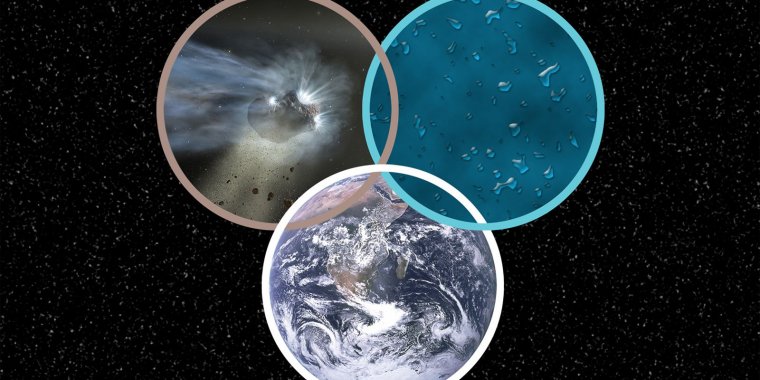| News / Science News |
Comet Provides New Clues to Origins of Earth's Oceans
A new study reveals that the water in many comets may share a common origin with Earth's oceans, reinforcing the idea that comets played a key role in bringing water to our planet billions of years ago.

Illustration of a comet, ice grains and Earth's oceans. SOFIA found clues in Comet Wirtanen's ice grains that suggest water in comets and Earth's oceans may share a common origin. Photo: NASA/SOFIA/L. Cook/L. Proudfit
The Stratospheric Observatory for Infrared Astronomy, SOFIA, the world's largest airborne observatory, observed Comet Wirtanen as it made its closest approach to Earth in December 2018. Data collected from the high-flying observatory found that this comet contains "ocean-like" water. Comparing this with information about other comets, scientists suggest in a new study that many more comets than previously thought could have delivered water to Earth.
Planets form from debris orbiting in a disk shape around a star; small pieces of debris can stick together and grow larger over time. Leftover debris remains in regions of our own solar system like the Kuiper Belt, beyond Neptune, or the Oort Cloud, far past Pluto. Comets come from these areas, but we can only see them when their orbits bring them closer to the Sun.
The heat from the Sun causes some of the dirty snow to vaporize, creating the fuzzy halo or "coma" of water vapor, dust and ice grains seen in comet images.
Scientists predict that the water in Earth's oceans came from water-carrying bodies in the early solar system that collided with our planet, similar to today's ice-rich asteroids or comets. But scientists do not know where in the formative disk these objects originated.
Water is also known by its chemical name H2O because it's made of two hydrogen atoms and one oxygen atom. But using special instruments, scientists can detect two types: regular water, H2O, and heavy water, HDO, which has an extra neutrally-charged particle called a neutron inside one of the hydrogen atoms. Scientists compare the amount of heavy to regular water in comets. If comets have the same ratio of these water types as Earth's oceans, it indicates that the water in both may share a common origin.
Observing at high altitudes above much of the Earth's atmospheric water allowed SOFIA to accurately measure the ratio of regular to heavy water in Comet Wirtanen. The data showed that Comet Wirtanen's water ratio is the same as the Earth's oceans.
When the team compared the new SOFIA data with previous studies of comets, they found a surprising commonality. The ratio of regular to heavy water was not linked to the origin of the comets - whether they were from the Oort Cloud or the Kuiper Belt. Instead, it was related to how much water was released from ice grains in the comet's coma compared to directly from the snowy surface.
This could imply that all comets could have a heavy-to-regular water ratio similar to Earth's oceans, and that they could have delivered a large fraction of water to Earth. (NASA)
YOU MAY ALSO LIKE



